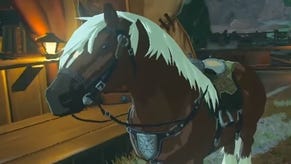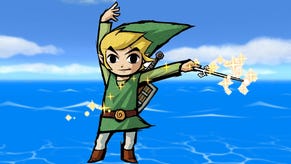The Legend of Zelda: The Minish Cap review
Link seems to have shrunk.
Order yours now from Simply Games.
Du-du-da-DA! It all comes down to that. Every time you encounter that symbolic fanfare, you've just found something worth cheering. You hear it a lot. And the journey to each salute is deliberately meandering and reliant on your constant adjustment to circumstances. That's the magic of the Zelda series; each game carries you along on a wave of minor victories and the creeping desire to make sure you've pulled back every curtain. The Minish Cap is no different. It strikes exactly the right balance between all the essential elements of a Zelda adventure, introducing a few suitably diverse new fundamentals in the process and bedding them in successfully, and it looks, sounds and handles exactly as you'd presume from what is slightly surprisingly the Game Boy Advance's first "proper" single player Zelda game.
A Link To The Past
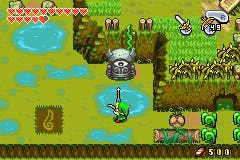
There are a few drawbacks, but we'll get to those later. In the meantime, here's the setup: Link - the prepubescent, Wind Waker-esque Link - wakes to find himself escorting his longstanding friend Princess Zelda to a festival that marks the hundredth anniversary of the last time the "Picori" were seen by the locals. Unfortunately, the centrepiece of the festival happens to backfire rather spectacularly when the finest swordsman of the day shatters rather than coveting the sacred Picori Blade he's fought for the honour of touching - spreading evil throughout the land - before turning the Princess into solid stone and vanishing in a puff of smoke.
Naturally Link is enlisted to save the day. At which point the game arrives and you, as a Zelda fan, know what to do. Gradually you start opening up sections of Link's top-down world as you wander around, talk to relevant people and gain the relevant equipment to disentangle the mesh of locked doors and blocked paths that bar your progress. All the while you're constantly exploring every nook and cranny, making a note of locked doors and distinctly crumbly walls for later when you may have the tools to deal with them, tinkering with the lay of the land through switches, block-pushing and other logic puzzles, and gathering things like heart pieces, hauls of rupees, specialist tools, extra munitions, "mysterious shells" and "kinstone" pieces - which, once "fused" with particular kinstones in the possession of other characters in the game world, will often open the path to various other uncharted caves. More grottos full of treats. More du-du-da-DAs!
And, most significantly, at intervals it gives you the satisfaction of tackling vintage Zelda dungeons - where you'll gradually explore subterranean labyrinths riddled with finely tuned puzzles, which leave you with an afterglow of warm satisfaction and admiration for the minds that dreamt up such cunning and seamless conundrums. Like a big barrel you're meant to pass through with two visible doors and four sets of steps leading down to it, which you discover you can rotate to change where the openings align. The Minish Cap doesn't shirk its responsibility to the series' fine reputation in this department; its dungeons draw gently on a wide variety of skills and tools along a squirrelly path that quickly satisfies the various criteria that make Zelda dungeons so unmistakable. The bosses are sometimes guilty of chasing the chess-like dungeons down with a noughts and crosses mixer, capitulating to strategies you dreamt up in scant seconds, but on the whole the experience is intoxicating in all the right ways.
The Borrowers
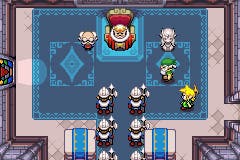
The progression of the story is such that before long you're in league with the Picori, a pixie-like race no taller than a couple of matchboxes - at least compared to our doughty young lead. This is all thanks to the introduction of an odd-looking green chap called Ezlo who perches on your head, helps you on your quest, and teaches you how to shrink yourself down to almost nothing. Using various portals - generally distinctive tree stumps - you can shrink down or grow back to normal size, and dungeons and general exploration rely on this shift in dimensions. It's not quite the yin-yang genius of A Link To The Past's twin light and dark realms, but it does supplement Link' existing disciplines in a manner that carves out new and unexpected pathways - and the developer explores its potential shrewdly.
Other new elements, some borrowed from other Zelda games like The Wind Waker, and a number of old favourites, continue to present themselves over the course of the game, subtly widening the criteria in your search for puzzle solutions and allowing you to make more of the lands you've already explored. Apart from your swords - for which you'll gradually accumulate more attacking techniques over the course of the game - and your trusty shield, there are bombs, bottles, boomerangs and the like to rediscover, and there are welcome additions like an item that allows you to climb certain cliff faces, one that sucks objects toward Link like a vacuum cleaner, and when you encounter spinning vortexes you can even use your Minish Cap as a makeshift parachute to help guide you beyond a geographical impasse.
But it's the interplay between various disciplines, alongside the slow-burning build-up and gradual accumulation of items, that makes The Minish Cap so satisfying. The sudden contemplation of what else you've encountered that might open up in the face of your latest discovery, and that equally impulsive urge to act on anything that comes to mind. Like when you discover the ability to clone yourself for a short time, doubling your strength and allowing you to hit multiple switches simultaneously, and then remember that cave or this house or that room in that place where it might apply. There are suddenly more veils to lift and fanfares to bask in. Most events and discoveries are similarly influential in ways that subtly reveal themselves in time.
Efficient
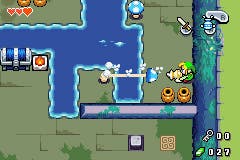
Happily, in delivering this latest take on the series' classic formula, the developers have made few technical or mechanical mistakes. Control is intuitive - you bind items to A and B on your inventory screen and the right trigger is a context-sensitive action button - while all the menus and the process of navigating them is efficient and justly unobtrusive. Meanwhile the minds beneath the Cap haven't been brave enough to deviate too often from the audio template laid out by previous Zeldas - so much so that you'll hear retouched tunes from Ocarina of Time, Majora's Mask, Wind Waker and others more often than you'll hear new music - even going so far as to draw on the bank of characters "voices" employed in recent Zeldas, but the visuals fall somewhere between the strong lines and cartoon-like simplicity of the 16-bit Link To The Past and the evolving face of the series' recent offerings.
Animation and character design is smooth and endearing and the themed areas of the world are detailed and distinctive, whether it's the misty dew-soaked woods in the east or the searing peak of the mountain to the northwest, with its tumbling boulders and tangibly sweltering mines. Or even the carnival atmosphere of the town square in the centre of the world map, with its many stalls, shops and houses with domed, pock-marked roofs that perch atop elaborate exteriors like marzipan beanie hats. If the goal was to find a middle ground between the recognisable lines of the peak of Zelda's top-down offerings and the strikingly stylised efforts of The Wind Waker, then the artists deserve their own du-du-da-DA! and a hearty pat on the back - which symbolically gives them the power to collect beer in jars or somesuch and then harvest kebabs.
Buuut, and we did warn you about this, there are drawbacks. In terms of what's on offer, they are few and forgivable - occasionally having your view obscured standing behind something by the perspective, not always getting the chance to reset puzzle pieces like pots and boulders easily (walking into and out of a room isn't often hard, but having to run a gauntlet of giant raindrops and bug-like monsters and then catapult yourself across a gorge because you accidentally rolled a boulder into a cul-de-sac seems a bit excessive), and sometimes having to traipse rather aimlessly because the map detail is a bit fuzzy spring to mind - but the biggest problem isn't to do with the game content, it's to do with the game length. It's too short.
Doff Cap
Hopefully we can get away with sidestepping the whole debate about how long a game really ought to be. It is somewhat subjective, and The Minish Cap is a gem for as long as it does sparkle unsolved in your cartridge slot, but given the length of previous Zeldas this one could come as something of a shock. We know people who have completed it in one day, and they weren't passing up the chance to smash the odd wall or solve the riddle of an unreachable treasure chest, either.
But then every wave has to splash down sometime, and while you're riding this one it's as pleasurable an experience as you could hope for. The formula remains the same but the experience is just as essential as ever - and every attempt to nudge it in a slightly new direction comes off without a hitch. If you can accept that it won't last you as long as you might like, then your quest is clear: leave no stone unturned in your search for this game, and then leave none of its stones unturned either.





